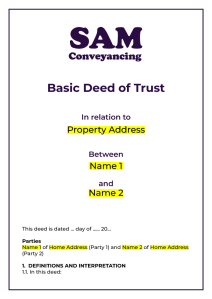Joint Ownership: Land Registry JO Form
- Form JO clarifies how joint owners will hold property (Joint Tenants, Tenants in Common 50/50, or Tenants in Common in unequal shares).
- It's not always a Land Registry requirement, but it's a valuable tool for ensuring clarity and avoiding future disputes.
- Some solicitors use it as a questionnaire to confirm a client's intentions, while others submit it to the Land Registry.
- Box 5 or 6 of the form sets out the ownership structure.
- A Deed of Trust complements Form JO, especially for unequal shares, by protecting your beneficial interest in a property and sets out your intentions.
What is the purpose of Form JO?
Joint Ownership Form JO is used to record how you and another person will jointly own a property. While not always submitted to the Land Registry, it's a crucial document that clarifies ownership intentions, especially when buying with someone else.
Some solicitors, like the ones on our panel, use it as a preliminary step to confirm the TR1 Form (property transfer form) accurately reflects your intentions.
Buying a property with someone else?
We not only hand-hold you both through the process alongside our expert property solicitors, but we are also a leading provider of bespoke Deeds of Trust, which can greatly assist your ownership regarding matters such as your future intentions on selling, efficient tax planning etc.
What are the different ways to own a property jointly?
There are three main ways to co-own property:
- Joint Tenants: You both own the entire property together. If one owner dies, the surviving owner automatically inherits the whole property. This is common for married couples or civil partners.
- Tenants in Common (50/50): You each own a distinct 50% share. If one owner dies, their share goes to their beneficiaries (as specified in their will), not automatically to the other owner.
- Tenants in Common (Unequal Shares): You each own a specified percentage of the property. This is often used when contributions to the purchase are unequal. A Deed of Trust is essential in these cases.
Want to view a Form JO?
Just click on HM Land Registry Form JO to view the official document.
The advantages and disadvantages of these ownership types
The best type depends on your individual circumstances and goals. Your beneficial ownership (not legal ownership) can be:
Joint Tenants
- It's simple, especially for couples. Full ownership automatically transfers to the survivor, avoiding probate for that share.
- Less flexible if you want to leave your share to someone other than the co-owner.
Tenants in Common (50/50)
- Allows you to leave your share to whomever you choose in your will.
- Requires probate for your share. Can be more complex if owners disagree about selling.
Tenants in Common (Unequal Shares)
- Reflects unequal purchase contributions. Offers flexibility, especially with a Deed of Trust.
- Allows beneficial owners to allocate rental income for tax efficiency.
- Requires careful documentation and a clear agreement, ideally in a Deed of Trust. Can be complex, especially with dynamic shares.
A Deed of Trust is highly recommended for Tenants in Common, and essential for those with unequal shares. It clarifies ownership percentages, outlines responsibilities, and details how property decisions will be made. It can also address specific scenarios, such as disagreements about selling. A Deed of Trust offers significant flexibility and protection.
A dynamic or Floating Deed of Trust might be useful for Tenants in Common because beneficial ownership shares can change over time depending on who is paying the mortgage or if one party offered up more money for a renovation, for example.
Deed of Trust contents are confidential and not public record, so you'll have privacy about your beneficial ownership shares. However, HMRC can demand access to a Deed of Trust as part of a criminal investigation.
It's important to note that if you're receiving income from a property you'll need to declare how it's split to HMRC through Form 17.
Protect your interest in a property and confirm how to sell. Drafted by a solicitor.
The first draft is within 1 to 2 working days* and includes:
- Deposit paid.
- The percentage ownership of each party.
- How to share expenses like the mortgage and bills.
- Share of property income - rent or gain on sale.
- How to sell the property.
- How the property is divided in the event of separation, divorce, or death.
What is a Form A restriction?
A Form A restriction prevents a tenant in common from selling without the other owner's consent, protecting each owner's interest. Upon a tenant in common's death, their will is consulted before any sale. A Deed of Trust is also vital here to, outline the beneficial owners' intentions.
The Form A restriction wording states the following:
"No disposition by a sole proprietor of the registered estate (except a trust corporation) under which capital money arises is to be registered unless authorised by an order of the court."
When should you make a Deed of Trust?
Ideally, finalise it before exchanging contracts and when you're reasonably sure that your purchase will go ahead. This is for clarity and to avoid potential stamp duty issues, so having the Deed of Trust before completion is crucial.
Declaration of Trust vs Deed of Trust
A Declaration of Trustisn't legally binding. It's a simpler document outlining basic ownership intentions. To be legally valid, it needs to be witnessed by a solicitor.
A Deed of Trust is legally binding and comprehensive, including detailed instructions on sale, beneficial ownership, and dynamic share percentages. A Form JO can reference a separate, detailed Deed of Trust.
At SAM, we only ever deal with a Deed of Trust (which includes a Declaration) and becomes legally binding once executed as a deed.
Can you change your joint ownership later?
Yes you can. You can change from Joint Tenants to Tenants in Common or from Tenants in Common to Joint Tenants.
You can contact us for more details on the joint ownership change and we'll be able to advise on your next steps.

We provide this severance and registration at the Land Registry for £260 INC VAT. You will need to upload your notice of severance.
Contact us through our online form below for a fixed-fee, no-obligation quote for our services.
Andrew started his career in 2000 working within conveyancing solicitor firms and grew hands-on knowledge of a wide variety of conveyancing challenges and solutions. After helping in excess of 50,000 clients in his career, he uses all this experience within his article writing for SAM, mainstream media and his self published book How to Buy a House Without Killing Anyone.
Caragh is an excellent writer and copy editor of books, news articles and editorials. She has written extensively for SAM for a variety of conveyancing, survey, property law and mortgage-related articles.










